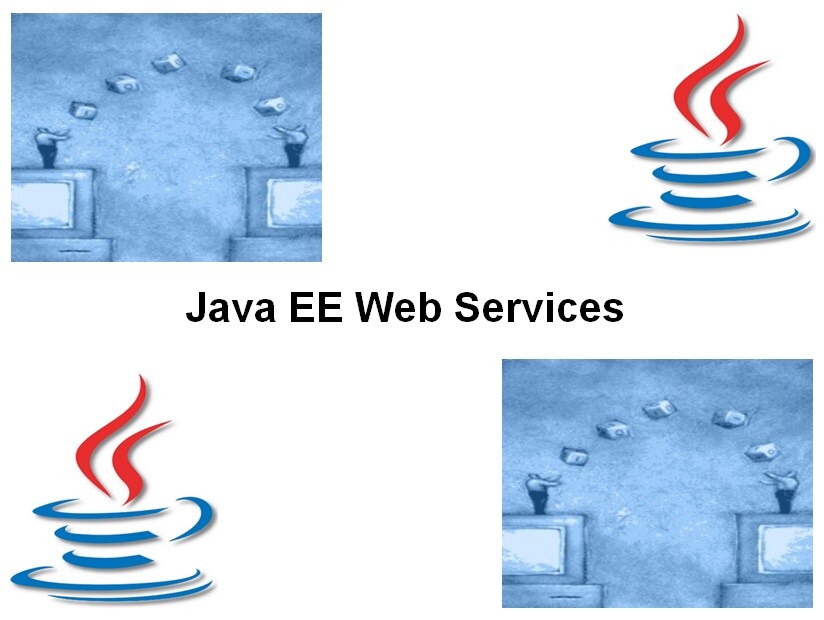-
Learning by doing
-
Trainers with practical experience
-
Classroom training
-
Detailed course material
-
Clear content description
-
Tailormade content possible
-
Training that proceeds
-
Small groups
In the course Java EE Web Services you will learn what Web Services are, how you can create Web Services in Java and how they can be accessed from Java and other platforms.
The course covers both SOAP Web services and REST Web services.
The various standards on which Web Services are based are treated, such as XML Schema, SOAP, WSDL and HTTP for REST Services.
In particular, attention is paid to the various Java APIs for Web Services such as JAX-WS 2.x, SAAJ (SOAP with Attachment API), JAXB (Java API for XML Binding) and JAX-RS.
Attention is also paid to what you should look out for to ensure that Web Services are interoperable between different platforms such as Java and .NET. Also the architecture of modern Single Page Applications with a REST service backend is discussed.
And finally, the various mechanisms and standards for the security of Web Services are discussed. This course covers the topics that are asked on the Oracle Java EE Web Services exam.
The course Java EE Web Services is aimed at experienced Java developers who want to develop Web Services in a Java EE environment.
To join this course, knowledge of and experience with programming in Java and Java EE Web Applications is required.
This course has a hands-on character. The theory is covered on the basis of presentation slides and is interspersed with practical exercises. Demos are used to clarify the theory. The course material is in English.
Participants receive an official certificate Java EE Web Services after successful completion of the course.

Module 1 : Web Services Intro |
Module 2 : SOAP |
Module 3 : SAAJ |
| What are Web Services? Distributed Applications Evolution Role of interface Interoperability Web Service Types Web Services Stack SOAP Web Services REST Web Services RPC Style Web Services Micro Services Document Style Web Services Service Oriented Architecture |
What is SOAP? SOAP Characteristics SOAP Messages SOAP Body SOAP Headers SOAP Namespaces SOAP Faults SOAP Version differences SOAP Messages as payload Message Exchange Patterns SOAP Intermediaries actor and mustUnderstand attribute |
What is SAAJ? SOAP message structure SOAP Message Parts SOAP Part Attachment Parts SAAJ and DOM SAAJ Class Hierarchy SAAJ Connections Creating a Message Adding Message Elements Sending and Receiving Accessing SOAP Body |
Module 4 : XML-Schema |
Module 5 : JAXB |
Module 6 : WSDL |
| Why XML-Schema? Well formed and valid documents What XML-Schema's? Markup Languages XML Schema Advantages XML Schema design models Classic Use of Schema's XML Namespaces Simple and Complex types XML Schema Data Types User Defined Data Types Derivation by Restriction Derivation by Extension |
XML Processing Options Java API for XML Binding JAXB Architecture JAXB Binding Life Cycle Role of Binding Compiler XML tot Java Mapping Rules Mapping of XML Schema Types JAXB API JAXB Annotations Types Binding Elements and Attributes Named Complex Types Customized Mappings Adapter Classes |
Web Service Description Language WSDL Usage WSDL and Code Generation WSDL in Web Service stack WSDL Namespaces WSDL Structure WSDL Elements Types and Messages PortType and Operations WSDL Bindings Service Element SOAP Messages Modes WSDL 2.0 |
Module 7 : JAX-WS |
Module 8 : Message Handlers |
Module 9 : Asynchronous Calling |
| What is JAX-WS? JAX-WS Design Goals JAX-WS Runtime System JAX-WS Tools Service Endpoint Models JAX-WS Servlet Endpoint Enterprise Java Beans Endpoints JAX-WS Architecture Client Side Programming Models Dynamic Proxy Invocation Model Dispatch Invocation Model |
Message Handlers Characteristics JAX-WS Handler Types SOAP Message Handlers Logical handlers Call Chain Inbound Messages Outbound Messages Processing the Payload Handler Chains Configuring Handler Chains |
Web Service Invocations Supporting Asynchrony Client Side Fire and Forget Client Side Polling Client Side Callbacks Enabling Asynchronous calls Callback Handler Calling Asynchronously Asynchronous Web Services Asynchronous Web Service Model Using WS-Addressing |
Module 10 : REST Services |
Module 11 : Interoperability |
Module 12 : Web Service Security |
| Representational State Transfer REST Web Service Principles ID and Links REST Services in Java JAX-RS and Rest Jersey Content Negotation Embedded Path Parameters @Path and @Param Multiple Representations @Produces and @Consumes Common REST Patterns Resources URI Access XML versus JSON |
WS Interoperability Organization Challenges and Deliverables Profiles Profile Standards Conformance Requirements WS-I Testing Tools Monitor and Analyzer Interoperability Technologies WS-Reliable Messaging WSDL Reliable Messaging Levels of Delivery Assurance Bootstrapping and Configuration Message Transmission Optimization |
Web Service Security Security at Transport level Security at XML Level XML Encryption XML Digital Signature XML Key Management WS-Security Security Enabled SOAP REST Security Access Restriction Restrict HTTP Methods JSON Web Tokens API Keys |
